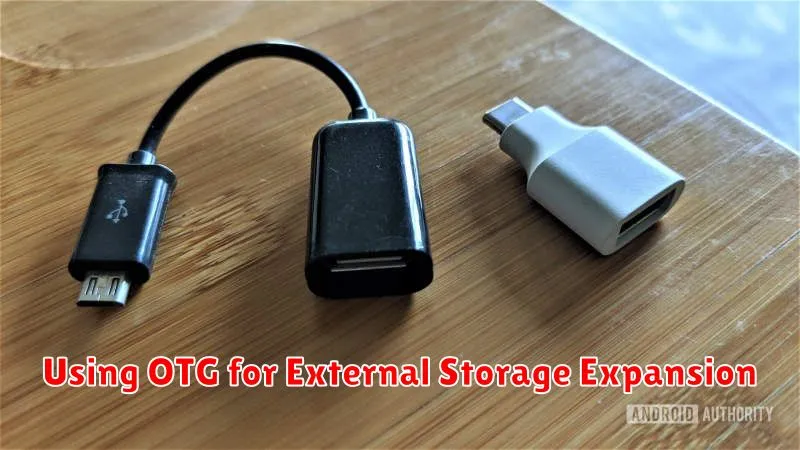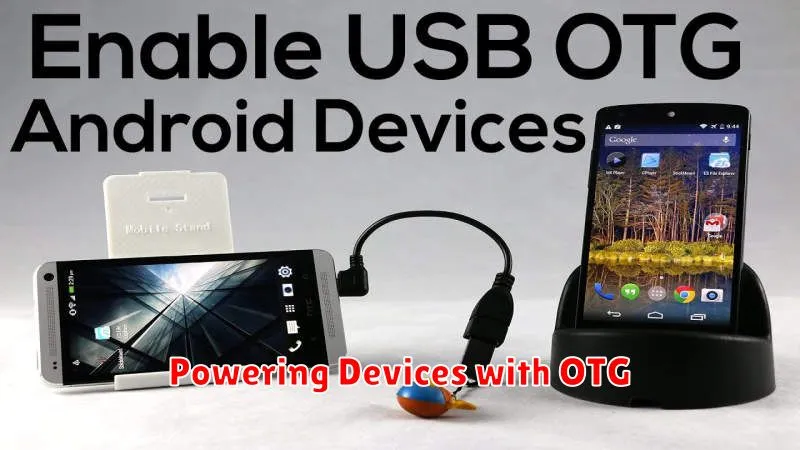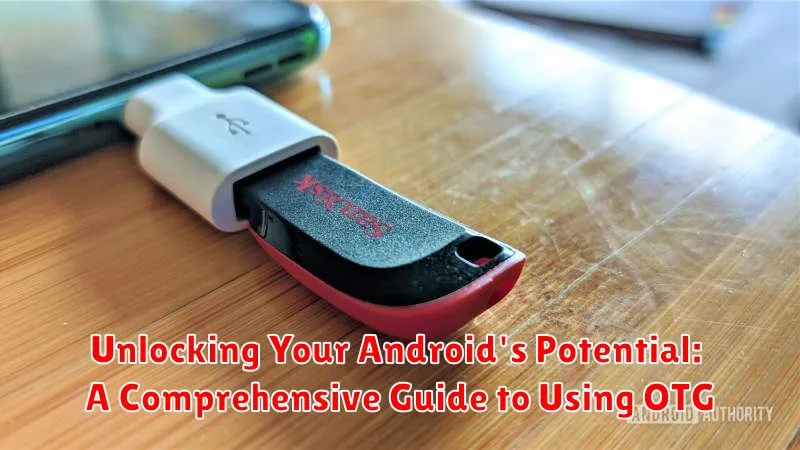Your Android device is capable of so much more than you might realize. Have you ever wished you could connect a USB drive, a keyboard, or even a game controller directly to your phone or tablet? With On-The-Go (OTG) technology, this hidden potential can be unlocked. This comprehensive guide explores the world of Android OTG, providing a clear understanding of what it is, how it works, and the numerous possibilities it opens up for expanding your device’s functionality. From transferring files effortlessly to enhancing your mobile gaming experience, OTG transforms your Android device into a powerful, versatile tool.
This guide delves into the intricacies of OTG support, helping you determine if your Android device is OTG compatible. We’ll cover the essential OTG cable you’ll need, walk you through the simple setup process, and showcase a wide range of practical applications. Whether you’re a tech-savvy user looking to maximize your device’s capabilities or a beginner curious about OTG’s potential, this guide equips you with the knowledge to harness the full power of Android OTG.
Understanding OTG and Its Benefits
OTG, or On-The-Go, is a powerful feature that significantly extends the functionality of your Android device. It allows your phone or tablet to act as a host, meaning it can connect directly to and power various USB peripherals. This transforms your Android from a simple communication device into a versatile hub for productivity and entertainment.
Essentially, OTG enables your Android device to communicate with and control external devices like it were a computer. This opens up a world of possibilities.
Benefits of Using OTG:
- Expanded Storage: Connect flash drives and external hard drives for additional storage capacity.
- Direct File Transfer: Easily move files between devices without a computer intermediary.
- Gaming Enhancement: Use controllers and gamepads for a console-like gaming experience.
- Peripheral Connectivity: Connect keyboards, mice, and printers for enhanced productivity.
By understanding and utilizing OTG, you can truly unlock the full potential of your Android device and transform the way you interact with it.
Checking for OTG Compatibility on Your Android Device
Before diving into the world of OTG, it’s crucial to verify if your Android device supports this functionality. There are several ways to determine compatibility.
Using a Physical OTG Cable
The most straightforward method is to try connecting a USB OTG cable to your phone. If the connected device powers on or is recognized by your phone, your device is OTG compatible.
Checking Device Specifications
Refer to your phone’s user manual or the manufacturer’s website. Look for mentions of “OTG,” “USB On-The-Go,” or “USB Host” support in the specifications.
Using a Third-Party App
Several apps available on the Google Play Store can check for OTG compatibility. These apps typically perform a quick scan of your device’s hardware and software to determine support.
Connecting OTG Devices to Your Phone
Physically connecting your device to your Android phone using OTG is straightforward. Locate the USB OTG port on your phone. This is typically the same port you use for charging. Then, simply plug in your OTG adapter.
Next, connect your USB device to the female USB port on the OTG adapter. This could be a flash drive, external hard drive, keyboard, mouse, or other compatible device. Your phone should automatically detect the connected device.
A notification will usually appear indicating a successful connection. This notification often provides options for interacting with the connected device, such as browsing files or selecting data transfer modes.
If no notification appears, you can usually access the connected device through a file manager app. Look for options like “USB Storage” or the name of the connected device.
Transferring Files Between Your Phone and OTG Devices
Once your OTG device is successfully connected, transferring files is generally straightforward. Your Android device should automatically detect the connected storage and display it in a file manager app. If a file manager doesn’t automatically appear, you can use your device’s pre-installed file manager or a third-party option from the app store.
Copying Files from Phone to OTG Device: Navigate to the files you wish to transfer on your phone. Select the desired files and folders. Look for options like “Copy” or “Move.” Then, navigate to the connected OTG device within the file manager and select “Paste” or “Move Here.” The transfer speed depends on factors like file size and the speed of your OTG device.
Copying Files from OTG Device to Phone: The process is similar in reverse. Locate the files on your OTG device using the file manager. Select the files and use the “Copy” or “Move” command. Navigate to the desired destination folder on your phone and choose “Paste.”
Troubleshooting Common OTG Issues
While OTG is generally plug-and-play, occasional issues can arise. Here are some common problems and their solutions:
OTG Device Not Recognized
If your Android device doesn’t detect the OTG device, try these steps: Ensure your OTG cable is functioning correctly. Sometimes, a faulty cable can be the culprit. Try a different cable if you have one. Reboot your Android device. A simple restart can often resolve temporary software glitches.
File Transfer Errors
Experiencing issues transferring files? Check the file system of your OTG device. Android may not support certain file systems. If necessary, reformat your OTG drive to a compatible format like FAT32.
Power Issues
Some OTG devices require more power than your phone can provide. If your device isn’t powering the OTG device, consider using a powered OTG hub. This allows you to connect the hub to an external power source, providing sufficient power to your connected devices.
Unsupported File Format
Your device might not have the necessary application to open the file. Install a relevant application from the Google Play Store to access files in unsupported formats. For instance, install a document viewer for specific document types, or a media player to play unsupported video formats.
Exploring Advanced OTG Usage
Beyond the basics of connecting flash drives and peripherals, OTG offers a surprising range of advanced functionalities. Connecting MIDI controllers allows musicians to create music on their Android devices with professional-grade equipment. This opens up possibilities for mobile music production and performance.
Gaming controllers significantly enhance the mobile gaming experience, providing tactile feedback and precision control. OTG transforms your Android device into a portable gaming console.
For professionals, connecting directly to cameras via OTG enables efficient image and video transfer for on-the-go editing and sharing. This streamlines workflows for photographers and videographers.
Moreover, using specialized equipment like USB microscopes or oscilloscopes extends OTG’s utility beyond common applications, demonstrating its versatility for scientific and technical endeavors.
Using OTG for External Storage Expansion

One of the most common and practical uses of OTG is expanding your Android device’s storage capacity. If you’re running low on internal space, an OTG cable allows you to connect external storage devices like USB flash drives and portable hard drives directly to your phone or tablet.
This provides a convenient way to access additional storage for media files, documents, and backups. Simply plug in the storage device using the OTG adapter, and your Android device should automatically detect it. You can then browse the files on the external drive using a file manager app.
Important Note: Formatting the external drive as exFAT or FAT32 is usually recommended for best compatibility with Android devices. NTFS may work but isn’t always fully supported.
Powering Devices with OTG

While primarily used for connecting peripherals, OTG also allows your Android device to act as a power source for other devices. This functionality, often referred to as “reverse charging” or “OTG reverse power,” can be incredibly useful in emergency situations or when a dedicated power bank isn’t available.
Important Note: Not all Android devices support OTG powering. Check your device’s specifications to confirm compatibility. Also, be mindful of your Android device’s battery level, as powering another device will drain its charge. Excessive use can impact your battery’s lifespan.
To use your Android device as a power source, you’ll need an OTG cable and a suitable charging cable for the device you want to power. Connect the OTG cable to your Android device and then connect the charging cable to the OTG adapter and the device you wish to charge.
The amount of power your Android device can provide is limited. While sufficient for charging smaller devices like smartwatches or headphones, it may not be enough for larger devices such as tablets or laptops. The charging speed will also be slower compared to a dedicated power source.

